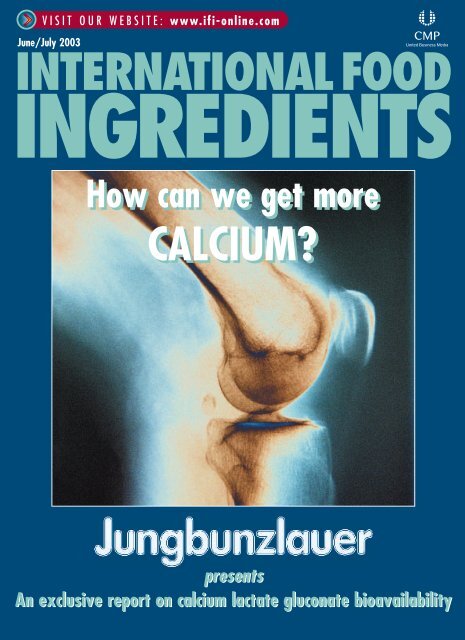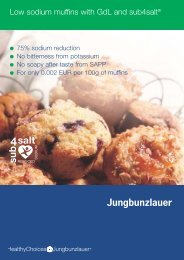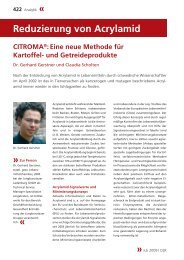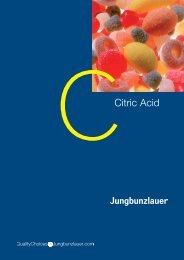How can we get more Calcium? - Jungbunzlauer
How can we get more Calcium? - Jungbunzlauer
How can we get more Calcium? - Jungbunzlauer
Create successful ePaper yourself
Turn your PDF publications into a flip-book with our unique Google optimized e-Paper software.
VISIT OUR WEBSITE: www.ifi-online.com<br />
June/July 2003<br />
INTERNATIONAL FOOD<br />
INGREDIENTS<br />
<strong>How</strong> <strong>can</strong> <strong>we</strong> <strong>get</strong> <strong>more</strong><br />
CALCIUM?<br />
presents<br />
An exclusive report on calcium lactate gluconate bioavailability
24<br />
The analysis of human bones from our mammoth-hunting ancestors<br />
show that the primitive food kept their skeletons healthier than our diet<br />
today. <strong>How</strong> <strong>can</strong> <strong>we</strong> <strong>get</strong> <strong>more</strong> calcium? DR GERHARD GERSTNER,<br />
<strong>Jungbunzlauer</strong> Ladenburg GmbH, focuses on absorption aspects of the<br />
readily bioavailable calcium lactate gluconate, which is increasingly<br />
used for calcium fortification of foods and beverages<br />
<strong>How</strong> <strong>can</strong> <strong>we</strong> <strong>get</strong> <strong>more</strong><br />
Tricalcium citrate (TCC), calcium lactate, calcium<br />
gluconate and calcium lactate gluconate (CLG),<br />
a mixture of calcium lactate and calcium gluconate,<br />
are organic calcium compounds often used in<br />
calcium supplements and calcium fortified foods. As<br />
shown in Table 1, their taste is mostly neutral and they<br />
offer a good combination bet<strong>we</strong>en a high calcium content<br />
and moderate calcium solubility (TCC) or<br />
bet<strong>we</strong>en a moderate calcium content and a good solubility<br />
(calcium lactate, calcium gluconate) or a very<br />
high solubility (CLG),<br />
The six to eleven-fold higher solubility of CLG<br />
compared to calcium lactate and calcium gluconate results<br />
from the fact that CLG is not simply the ‘sum’<br />
of both salts, but consists of calcium-, lactate- and<br />
gluconate-ions and of calcium 2+ -ions complexed by<br />
lactate and gluconate in a specific, pH- and concentration-dependent<br />
equilibrium.<br />
The absorption of dietary calcium may in part be<br />
determined by the balance bet<strong>we</strong>en calcium ions<br />
(Ca 2+ ), calcium complexes and insoluble calcium salt<br />
in the diet, or by the formation of these species in the<br />
intestinal lumen. It is often assumed, that calcium is<br />
absorbed only in the form of dissolved Ca 2+ . It has<br />
been shown by measuring bi-directional calcium<br />
fluxes in vitro across segments of the intestine 1 that indeed<br />
calcium is absorbed preferentially in its ionic<br />
form, while calcium complexes are absorbed intestinally<br />
to a lesser degree.<br />
Heaney et al 2 also found that solubility and absorbability<br />
of different calcium compounds are not<br />
linked proportionally with each other, ho<strong>we</strong>ver extreme<br />
differences in solubility of calcium compounds<br />
do play a role with regard to absorption levels.<br />
DISSOLUTION OF CLG<br />
Besides solubility the dissolution speed of a calcium<br />
salt is of certain importance to its bioavailability, at<br />
least when calcium bioavailability is estimated through<br />
a single measurement of the postprandial calcium concentration<br />
peak in serum or urine.<br />
Measuring the dissolution velocity of different calcium<br />
preparations, Arteaga et al 3 found that among<br />
powders and effervescent preparations CLG and TCC<br />
had the better dissolution velocities in vitro, that <strong>we</strong>re<br />
independent of pH (95-105% of both salts <strong>we</strong>re dissolved<br />
within 60 min at room temperature).The dissolution<br />
velocity of several calcium carbonate preparations<br />
ranged from negligible 0.7±0.8% under conditions<br />
of achlorhydria (pH 6.9) to 77.2±17.5% at pH<br />
1.5. Solubility of complex-forming soluble organic salts<br />
as CLG or TCC is largely pH-independent 3 . Therefore,<br />
complex-forming soluble organic salts such as CLG or<br />
TCC are better suited than calcium carbonate for<br />
achlorhydric subjects or elderly people of whom gastric<br />
acid production is frequently decreased.<br />
CALCIUM ABSORPTION OF CLG<br />
The fractional absorption rate of calcium from <strong>we</strong>ll<br />
absorbable soluble calcium salts and from milk ranges<br />
bet<strong>we</strong>en 25 and 33% in healthy subjects. Werner et<br />
al 4 compared true calcium absorption from CLG and<br />
TABLE 1. PROPERTIES OF CLG COMPARED TO OTHER COMMONLY USED SOLUBLE ORGANIC CALCIUM SALTS IN WATER<br />
Product <strong>Calcium</strong> content Solubility Solubility Taste<br />
[g/L water] [g Ca/L water]<br />
<strong>Calcium</strong> lactate gluconate 13% 400 52 Neutral<br />
<strong>Calcium</strong> lactate 13% 66 9 Bitter at<br />
higher<br />
concentrations<br />
<strong>Calcium</strong> gluconate 9% 35 3 Neutral<br />
<strong>Calcium</strong> citrate 21% 1 0.2 Neutral<br />
INTERNATIONAL FOOD INGREDIENTS NO. 3 2003
WORLD FOOD WATCH 25<br />
CALCIUM?<br />
<strong>Calcium</strong><br />
intake is not sufficient<br />
in our society - drawing <strong>more</strong><br />
attention to the bioavailability<br />
of the calcium in our diet<br />
foods, applying a highly precise double isotope technique.<br />
Eight healthy subjects (44-58 years) ingested in<br />
randomised order a CLG effervescent tablet (containing<br />
500 mg Ca), milk (620 mg Ca) or a breakfast<br />
(equal to 580 mg calcium). All test preparations <strong>we</strong>re<br />
labelled with 44 Ca and given on an empty stomach,<br />
whereas 42 Ca was injected intravenously. Corresponding<br />
to the high solubility of CLG, fractional true calcium<br />
absorption from CLG (28.7±9.1%) was higher<br />
than from milk (24.0±5.4) or the meal (17.9±7.1).<br />
<strong>How</strong>ever, the majority of investigations in true or<br />
apparent calcium absorption from CLG or in metabolic<br />
responses to supplementary calcium loads did<br />
not use the pure salt but a mixture of CLG with calcium<br />
carbonate (CLG+C). Addition of calcium carbonate<br />
to CLG reduces tablet size mainly due to the<br />
higher calcium content of the carbonate salt. Therefore,<br />
CLG supplements currently prescribed by physicians<br />
often contain calcium carbonate (ie <strong>Calcium</strong><br />
Sandoz Forte). <strong>Calcium</strong> absorption from such a mixture<br />
ho<strong>we</strong>ver may be lo<strong>we</strong>r than from pure CLG, possibly<br />
because the concentration of calcium lactate and<br />
gluconate in CLG+C is lo<strong>we</strong>r compared to CLG. Unfortunately,<br />
there is no published clinical trial comparing<br />
CLG+C directly with pure CLG.<br />
In a study by Behne et al 5 , two doses CLG+C,<br />
equivalent to 500 or 1000 mg calcium, <strong>we</strong>re administered<br />
orally to eight healthy young adults (22-32<br />
years), and calcium absorption was determined applying<br />
a double isotope method. Irrespective of the<br />
<strong>Calcium</strong> dose, absorption was about 30%, being on<br />
the same level as CLG alone.<br />
In all the other studies, in which calcium absorption<br />
was measured either applying double isotope techniques<br />
or by faecal excretion or whole body retention<br />
of a single calcium isotope, minimum values of fractional<br />
calcium absorption from CLG+C lay bet<strong>we</strong>en<br />
17 and 26%. This was equal to or less than the absorption<br />
of calcium carbonate (20% or 22.8-25.6%,<br />
respectively) in studies of Berstad 6 and Ekman 7 , less<br />
than absorption from a TCC solution (29.3%) but<br />
comparable with a suspension of TCC (25%) 8 .<br />
EFFECTS OF CLG ON IONISED CALCIUM AND<br />
PTH<br />
Several investigations in bioavailability of CLG made<br />
use of biomarkers instead of measuring calcium absorption<br />
directly. Preferred markers are the postprandial<br />
calcaemic and calciuric response to and the decrease<br />
in serum parathyroid hormone (PTH) levels<br />
following oral administration of calcium supplements<br />
or calcium-rich foodstuffs.<br />
Comparing the postload serum calcium and PTHresponse<br />
following administration of 400 mg calcium<br />
to nine healthy female volunteers (24-34 years) either<br />
as CLG+C or in Emmentaler cheese (considered as a<br />
very good source of dietary calcium), milk, spinach<br />
and sesame seed, Kärkkäinen et al 9 found, that<br />
CLG+C induced a higher increase in serum ionised<br />
calcium than cheese, milk, ve<strong>get</strong>able foodstuffs or the<br />
control and a signifi<strong>can</strong>t greater decline in serum intact<br />
PTH than milk, spinach or sesame seed.<br />
A signifi<strong>can</strong>t increase in urinary calcium excretion<br />
was observed following CLG+C, milk and cheese , but<br />
not after spinach or sesame seed. These data give indication<br />
of a comparable high calcium bioavailability<br />
from CLG+C and Emmentaler cheese, which is better<br />
than that from milk and much better than cal- <br />
INTERNATIONAL FOOD INGREDIENTS NO. 3 2003
26<br />
WORLD FOOD WATCH<br />
TABLE 2: EFFECTS OF CALCIUM (CA) SUPPLEMENTATION WITHOUT ADDITIONAL VITAMIN D ON<br />
BONE MINERAL DENSITY (BMD) OF THE LUMBAR SPINE. CHANGES ARE PRESENTED AS A<br />
PERCENTAGE FROM BASELINE AFTER 12-48 MONTH OF INTERVENTION 19<br />
Age Ca supplemented per day Ca diet %Increase in BMD 1 from Reference<br />
CLG+C<br />
68 y 1000mg 990 mg +1.8 20<br />
58 y 1000mg 760 mg +0.2 21<br />
58 y 1000mg 700 mg +0.8 22<br />
62 y 1000mg 820 mg +0.2 23<br />
64 y 1000mg NR +0.8 24<br />
70 y 500mg NR +1.0 25<br />
65 y 500mg NR +1.5 to +1.8 26<br />
Ca Citrate<br />
66 y 1250mg 700 mg +2 - +2,8 27<br />
63 y 500mg 875 mg -0.8 to -0.1 28<br />
Ca Citrate Malate<br />
60 y 500mg 400 mg -1.0 to -0.3 29<br />
Ca Carbonate<br />
63 y 500mg NR -0.4 to +0.4 30<br />
64 y 500mg NR -0.5 31<br />
60 y 500mg 400 mg -0.3 to -2.0 29<br />
1lumbar spine; NR = not recorded<br />
INFORMATION<br />
<strong>Jungbunzlauer</strong><br />
Europe - tel: +41 61 295 5100<br />
Fax: +41 61 295 5108<br />
E-mail: worldsales@jungbunzlauer.ch<br />
USA - tel:+1 617 969 0900<br />
Fax: +1 617 964 2921<br />
E-mail: info@jungbunzlauerinc.com<br />
cium bioavailability of ve<strong>get</strong>able sources like<br />
spinach or sesame seed.<br />
Other clinical studies in the metabolic response (i.e.<br />
PTH and urinary and serum ionised Ca 2+ ) to 500 or<br />
1000 mg calcium in the form of CLG, CLG+C or<br />
other Ca-supplements are hardly to compare with<br />
each other and do not allow a ranking of different calcium<br />
sources. Alto<strong>get</strong>her they show a high absorbability<br />
or bioavailability, respectively, of calcium from<br />
CLG or CLG+C 10-16 .<br />
IMPROVING BONE HEALTH WITH CLG<br />
The main purpose of the recommended high calcium<br />
intake is osteoporosis prevention. Therefore an increase<br />
in bone mineral density (BMD) or bone stability<br />
is a better criterion for the efficacy of a calcium salt<br />
than its absorbability.<br />
CLG, when administered to 19 nonmenopausal<br />
women with osteoporosis during or after a hormone<br />
therapy, signifi<strong>can</strong>tly reduced bone fracture rate 17 .<br />
Moreover, in a study in 50 Chinese women, aged 62-<br />
92, CLG increased BMD of the hip <strong>more</strong> than exercise<br />
18 .<br />
Additional evidence of beneficial effects on bone<br />
health of CLG+C was supplied by a meta-analysis of<br />
Schaafsma et al 19 . The authors compared 16 clinical<br />
studies in elderly and late postmenopausal women<br />
(mean age 58-79 years), who <strong>we</strong>re supplemented for<br />
12-48 month with 500-1250 mg/d calcium as<br />
CLG+C, Ca carbonate, Ca citrate, and other salts.<br />
Without exception, intake of CLG+C increased BMD<br />
of the lumbar spine by + 0.2 to +1.8%, whereas other<br />
supplements, even very <strong>we</strong>ll absorbable salts as Ca citrate<br />
malate, partly decreased BMD (Table 2).<br />
CONCLUSION<br />
CLG has the benefit to be among the most soluble<br />
calcium salts used for calcium supplementation, displaying<br />
a rapid rate of dissolution, a high stability and<br />
also a neutral taste, even at higher concentrations.<br />
Further to its excellent solubility, it is <strong>we</strong>ll absorbed<br />
and shows a high bioavailability in human studies (up<br />
to 30 %), which is equal or even superior to calcium<br />
bioavailability of milk.<br />
Most available studies did not evaluate CLG alone,<br />
but rather the combined supplement CLG + calcium<br />
carbonate. A recent meta-analysis of this combination<br />
and other calcium sources revealed that it was both<br />
signifi<strong>can</strong>tly and <strong>more</strong> consistently able to increase<br />
bone mineral density of the lumbar spine in elderly<br />
women. This effect may even be <strong>more</strong> pronounced<br />
when CLG is applied without calcium carbonate.<br />
REFERENCES<br />
1.Favus MJ, Pak C (2001) Am J Ther 8: 425-31<br />
2. Heaney RP et al (1990) Calc Tissue Int 46: 300-4<br />
3. Arteaga E et al (1996) Reu Med Chil 124: 1325-33<br />
4. Werner E et al (1999) Is Env Health Stud 35: 111-8<br />
5. Behne D et al (1978) Klin Wochenschrift 56: 69-74<br />
6. Berstad A et al (1976) S<strong>can</strong>d J Gastro 11: 747-51<br />
7. Ekman M et al (1991) Bone 12: 93-7<br />
8. Hansen C et al (1996) Osteoporosis Int 6: 386-93<br />
9. Kärkkäinen MUM et al.(1997) AJCN 65: 1726-30<br />
10. Cappuccio FP et al (1987) Journal Hypertension 5:<br />
67-71<br />
11. Deroisy R et al (1997) Clin Rheumatol 16: 249-53<br />
12. Johnson RN (1991) Eur J Clin Nutr 45: 117-9<br />
13. Reid IR et al (1986) Aust NZ J Med 16:193-7<br />
14. Reginster JY et al (1993) Osteoporosis Int 3: 271-5<br />
15. Gonnelli S et al (1995) Calcif Tissue Int 57: 175-7<br />
16. Praet JP et al (1998) J Endocrin Invest 21: 262-7<br />
17. Almustafa M et al (1992) Q J Med 83: 283-94<br />
18. Lau EM et al (1992) Osteoporos Int 2: 168-73<br />
19. Schaafsma A et al. (2001) Crit Rev FSN 41: 225-49<br />
20. Devine A et al. (1997) Osteoporos Int 7: 23-8<br />
21. Reid IR et al. (1993) N Engl J Med 328: 460-<br />
22. Reid IR et al. (1995) Am J Med 98: 321-5<br />
23. Prince R et al. (1995) J Bone Miner Res 10: 1068-75<br />
24. Ravn P et al. (1996) Bone 19: 527-33<br />
25. Overgaard K et al (1992) BMJ 305: 556-61<br />
26. Thamsborg G et al. (1996) Bone 18: 207-12<br />
27. Riggs LB et al (1998) J Bone Miner Res 13: 168-74<br />
28. Montessori MLM et al (1997) Osteop Int 7: 52-8<br />
29. Dawson-Hughes B et al (1990) N E J Med 323: 878-<br />
83.<br />
30. Devogelaer JP et al (1996) Bone 18: 141-50<br />
31. Liberman UA et al (1995) N Engl Journal Med 333:<br />
1437-43<br />
IFI<br />
INTERNATIONAL FOOD INGREDIENTS NO. 3 2003





